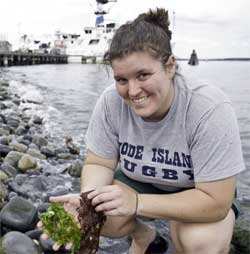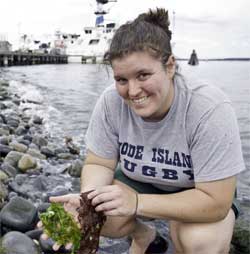 Clinton Township, Mich., resident examines seaweed/snail interactions
Clinton Township, Mich., resident examines seaweed/snail interactions
KINGSTON, R.I. – July 16, 2008 – University of Rhode Island senior Emily Blair has a somewhat surprising revelation. She likes seaweed.
“Most people think of it as nasty green stuff, but there are a lot of different kinds and it’s fun working with it,” said the resident of Clinton Township, Mich., who is studying marine biology at URI.
She admits, however, that she isn’t a fan of every kind of seaweed. She describes one, called Neosiphonia, as “a branching brown boring-ness that seems to be taking over some parts of the intertidal zone” of Narragansett Bay.
Blair is spending her summer elbow deep in seaweed – called macro-algae by scientists — in a research project aimed at determining the effect that snails have on the growth and recruitment of Neosiphonia, an invasive species from Asia, and the native species Ceramium, which she described as being “red with little lobster pinchers on the end.”
Invasive species often compromise the diversity of wildlife in the environment because they have no natural predators in the area. Blair’s research project, in collaboration with URI biology professor Carol Thornber and graduate student Nicole Rohr, will help determine if native snails may be able to keep Neosiphonia in check or if, by feeding only on native seaweeds like Ceramium, the snail is helping it to spread.
“Invasive species are a problem almost everywhere,” said Blair, who became interested in marine biology after she learned to scuba dive as a fifth grader. “The first step in dealing with them is figuring out what kind of impact they have. That’s what we’re doing this summer.”
Blair spent most of June and July visiting several coastal areas to set up her experiment. “We put a piece of rope in a bucket in the intertidal zone and waited for the algae to grow on the rope,” she explained. “Then we put snails in with it, waited some more, and removed the rope from the bucket. Now, under a microscope, we’re identifying everything on the ropes and figuring out whether the snails had any effect.”
Blair’s research was funded through the URI Coastal Fellows Program, a unique program designed to involve undergraduate students in addressing current environmental problems. Now in its 12th year, the Coastal Fellows Program teams students with faculty, research staff and graduate students to help them gain skills that will ensure their future success.
The seaweed project isn’t Blair’s first experience conducting field research. During the summer after her freshman year at URI she participated in a project to create maps of subaqueous soils in estuaries around Rhode Island. She collected and analyzed core samples of the sediments found at the bottom of salt ponds and bays in the area.
With just one more year of her undergraduate education to go, Blair is considering her options for her life after graduation. She said she will probably go to graduate school in hopes of eventually getting a job conducting marine ecology research or conservation.
“Whatever I end up doing, it will most likely have something to do with marine invertebrates or algae,” she said. “Algae has been a good time this summer.”
Pictured above
Emily Blair
URI Department of Communications & Marketing photo by Michael Salerno Photography.

